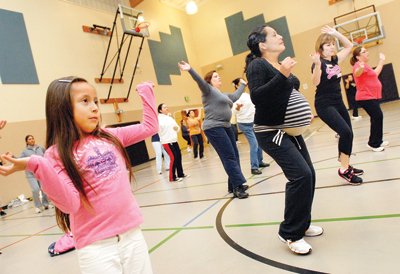Uno! Dos! Uno! Dos! Uno! Dos!
A fitness instructor shook her body like a pair of maracas to
sassy salsa rhythms flowing out of loudspeakers in the background,
and even bystanders couldn’t resist a foot tap, handclap or subtle
wiggle of the hips.
Uno! Dos! Uno! Dos! Uno! Dos!
A fitness instructor shook her body like a pair of maracas to sassy salsa rhythms flowing out of loudspeakers in the background, and even bystanders couldn’t resist a foot tap, handclap or subtle wiggle of the hips.
It’s fresher than Jazzercise. It’s less faddish than Yoga Booty Ballet.
It’s Zumba. And it’s contagious.
A sea of movement shuffled back and forth, side to side Nov. 30 inside the gym on the South Valley Junior High School campus at 277 IOOF Avenue, where dancers all ages and build stretched to every corner of the building for Zumba. The hybrid fitness program fuses hypnotic Latin tempos and easy-to-follow moves in a pulsing workout routine fashioned after a boisterous dance party.
From the sheer volume of dancers, it’s surprising to think the class once averaged participants of 10 or less.
But Zumba’s just as fun to do, as it is to pronounce – just ask one of roughly 105 attendees now showing up to shake their stuff on a regular basis.
“It’s not routine,” said participant Leticia Magana, 46. “It breaks the monotony. And you can put as much into it as you want.”
With its zesty beats, let-loose attitude and soundtrack-goody bag of musical genres including merengue, reggaeton, belly dancing, Hip-Hop, cumbia and tango, Zumba attracts a broad spectrum of participants, from teenagers to seniors to kids.
On the night of Nov. 30 when facilitators held a Zumba Fitness Party, a little girl who looked no older than 10 twirled around (sometimes in the opposite direction as everybody else), dancing on the balls of her feet like it was nobody’s business. She was one of about a dozen youngsters who attended.
“It’s the best exercise, because you’re always doing something different,” said Magana.
The concept made a huge splash when Beto Perez, a celebrity fitness trainer from Columbia, ran with the idea after an improvised workout session evolved into a wildly popular routine.
But bringing Zumba to Gilroy was no chance event. It was a strategic effort set into motion by a handful of collaborative community leaders, all of whom share a common initiative of reducing the overarching impact of diabetes in Gilroy.
The class, which costs $1, has been going on for about a year and a half, and is funded by a diabetes prevention grant from the Center for Disease Control’s REACH program (Racial and Ethnic Access to Community Health Education).
Hugo Torres, director of Proyecto Movimiento – a Type II Diabetes prevention program within the YMCA of Silicon Valley – said the Santa Clara County Public Health Department played an instrumental role in the writing and implementation of the grant that made Zumba possible.
“This class in Gilroy means a lot to me,” said instructor Elena Olsvold, who also works as a coordinator for a diabetes program at Saint Louise Regional Hospital in Gilroy. “I believe exercise dancing is great; the women are having fun, burning calories and are helping their bodies to lose extra pounds and feel happier.”
Lillian Castillo, who works in the Chronic Disease and Injury Prevention sector of the Santa Clara County Public Health Department, said supportive data from the department’s Behavioral Risk Factor Survey 2010 (BRFS) allowed health-related agencies such as the YMCA to tailor program planning, and cater to individual needs of demographics.
“Up until now, we did not have Gilroy-specific data,” she said. “(Zumba) is located in an area that is definitely high-need.”
According to the BRFS 2010, 14 percent of Gilroy respondents reported being diagnosed with diabetes versus eight percent countywide, and nine percent California-wide.
Diabetes, said Castillo, is associated with being overweight, ethnicity and poverty. She said 66 percent of Gilroy adults are overweight; 59 percent of Gilroy is Latino and three out of 10 residents live below federal poverty levels, according to the BRFS 2010.
Castillo explained this was the first year Gilroy was targeted for sampling, giving county health officials data statistics specific to the city – allowing for efficient implementation of health programs specific to the needs of the area.
Zumba, said Castillo, requires no special knowledge or clothing, is accessible, non-intimidating and – most importantly – fun.
“When I first started teaching Zumba, no one really knew what it was,” remembered Osvold. “The first class probably had 10 people … I’ve seen the class get up to 120.”
The zesty routine caught on fast, and is multiplying in attendance as friends continue to bring more friends.
Torres is already looking ahead to 2012, when the program’s five-year grant – now in its fourth year – will be up for renewal.
A refreshment of funds, he explained, is contingent on progress in elements such as participation and reductions in body mass index.
When Zumba first began, Torres said 20 “zumbistas” volunteered to be a part of an evaluation. They had their age and weight recorded, then walked one mile. Afterward, they had their pulse and heart rate measured.
The same procedure was repeated three months later.
“There’s power in numbers,” said Torres. “All have reduced numbers around the track; also their heart rate.”
Should Zumba continue to grow in popularity, both Torres and Osvold are interested in securing another venue for an additional class. If there’s a market for people wanting to exercise, Torres said, hopefully they can find a way to sustain the demand.
He mentioned working with the city’s Parks and Recreation Department for possibly coordinating future use of the city’s facilities.
“A lot of these folks can’t afford a gym membership,” said Torres, who pointed out the $1 class fee goes toward paying for facilities rental, the instructor and promotional material. “We’re making a difference here.”
Magana said she’s noticed an upswing in the attitude and energy of women who have been around for a while.
“I was telling the instructor, I see them losing weight!” she said. “They look different, they act different. I thought that was really inspiring.”















